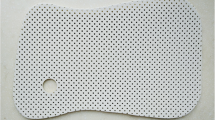Abstract
Introduction
The majority of displaced distal radius fractures are managed by closed reduction and cast immobilisation. Redisplacement is associated with initial displacement, imperfect reduction and quality of cast. The aim of this study was to establish which factors predict the risk of redisplacement.
Materials and methods
A retrospective analysis between September 2010 and April 2013 of children who underwent closed manipulation and cast immobilisation for a distal third radius fracture was performed. Open fractures, those treated with fixation, and cases with associated dislocations or physeal injuries were excluded. Initial fracture translation and angulation, the distance from the physis and the presence of an ulna fracture were recorded. Intra-operative radiographs were analysed to assess reduction, the cast index and gap index. Clinic records and post-operative radiographs were reviewed to identify redisplacement or further surgical intervention.
Results
During the study period, 107 children underwent closed reduction and casting: 82 boys (76.6 %) and 25 girls (23.4 %), and the mean age of the group was 10 years. Twenty-nine children (27 %) suffered a radiographic redisplacement although only five children underwent a second surgical intervention. Statistically significant risk factors for redisplacement were initial fracture translation (p < 0.001), success of reduction (p < 0.001) and associated ulna fracture (p = 0.021). Both the mean cast index (0.81 vs. 0.78) and mean gap index (0.16 vs. 0.14) were higher in the redisplaced group, but this did not reach statistical significance.
Conclusion
Closed reduction and immobilisation of paediatric distal radius fractures is associated with a high redisplacement rate. Initial fracture type and success of reduction are key risk factors.



Similar content being viewed by others
References
Cheng JC, Shen WY (1993) Limb fracture pattern in different pediatric age groups: a study of 3350 children. J Orthop Trauma 7:15–22
Armstrong PF, Joughin VE, Clarke HM (2008) Pediatric fractures of the forearm, wrist, and hand. In: Greene NE, Swiontkowski MF (eds) Skeletal trauma in children, 4th edn. Saunders, Philadelphia, pp 159–206
Bae DS (2008) Pediatric distal radius and forearm fractures. J Hand Surg Am 33(10):1911–1923
Jones K, Weiner DS (1999) The management of forearm fractures in children: a plea for conservatism. J Pediatr Orthop 19(6):811–815
Devalia KL, Asaad SS, Kakkar R (2011) Risk of redisplacement after first successful reduction in pediatric distal radius fractures: sensitivity assessment of casting indices. J Pediatr Orthop B 20(6):376–381
Miller BS, Taylor B, Widmann RF, Bae DS, Synder BD, Waters PM (2005) Cast immobilisation versus percutaneous pin fixation of displaced radial fractures in children: a prospective, randomised study. J Paediatr Orthop 25:490–494
Alemdaroğlu KB, Iltar S, Cimen O, Uysal M, Alagöz E, Atlihan D (2008) Risk factors in redisplacement of distal radial fractures in children. J Bone Joint Surg Am 90(6):1224–1230
Van Leemput W, De Ridder K (2009) Distal metaphyseal radius fractures in children: reduction with or without pinning. Acta Orthop Belg 75(3):306
Proctor MT, Moore DJ, Paterson JMH (1993) Redisplacement after manipulation of distal radial fractures in children. J Bone Joint Surg 75-B:454
Mani GV, Hui PW, Cheng JCY (1993) Translation of the radius as a predictor of outcome in distal radial fracture of children. J Bone Joint Surg 75-B:808–811
Zamzam MM, Khoshhal KI (2005) Displaced fracture of the distal radius in children: factors responsible for redisplacement after closed reduction. J Bone Joint Surg Br 87(6):841–843
McLauchlan GJ, Cowan B, Annan IH, Robb JE (2002) Management of completely displaced metaphyseal fractures of the distal radius in children. A prospective, randomised controlled trial. J Bone Joint Surg 84B(3):413–417
Haddad FS, Williams RL (1995) Forearm fractures in children: avoiding redisplacement. Injury 26:691–692
Gibbons CL, Woods DA, Pailthorpe C, Carr AJ, Worlock P (1994) The management of isolated distal radius fractures in children. J Pediatr Orthop 14:207–210
Charnley J (1999) The closed treatment of common fractures. Colt Books, Cambridge
Chess DG, Hyndman JC, Leahey JL, Brown DC, Sinclair AM (1994) Short arm plaster cast for distal pediatric forearm fractures. J Pediatr Orthop 14(2):211–213
Kamat AS, Pierse N, Devane P, Mutimer J, Horne G (2012) Redefining the cast index: the optimum technique to reduce redisplacement in pediatric distal forearm fractures. J Pediatr Orthop 32(8):787–791
Malviya A, Tsintzas D, Mahawar K, Bache CE, Glithero PR (2007) Gap index: a good predictor of failure of plaster cast in distal third radius fractures. J Pediatr Orthop B 16(1):48–52
Nietosvaara Y, Hasler C, Helenius I, Cundy P (2005) Marked initial displacement predicts complications in physeal fractures of the distal radius. An analysis of fracture characteristics, primary treatment and complications in 109 patients. Acta Orthop 76(6):873–877
Jordan RW, Westacott DJ (2012) Displaced paediatric distal radius fractures—when should we use percutaneous wires? Injury 43(6):908–911
Voto SJ, Weiner DS, Leighley B (1990) Redisplacement after closed reduction of forearm fractures in children. J Pediatr Orthop 10:79–84
Inglis M, McClelland B, Sutherland LM, Cundy PJ (2013) Synthetic versus plaster of Paris casts in the treatment of fractures of the forearm in children: a randomised trial of clinical outcomes and patient satisfaction. Bone Joint J 95(9):1285–1289
Conflict of interest
The authors confirm they have no conflict of interest (financial or non-financial) to declare. No funding was received in the production of this manuscript.
Ethical standards
The study was registered locally, but as this was a retrospective study, ethical committee approval was not required or sought.
Author information
Authors and Affiliations
Corresponding author
Rights and permissions
About this article
Cite this article
Jordan, R.W., Westacott, D., Srinivas, K. et al. Predicting redisplacement after manipulation of paediatric distal radius fractures: the importance of cast moulding. Eur J Orthop Surg Traumatol 25, 841–845 (2015). https://doi.org/10.1007/s00590-015-1627-0
Received:
Accepted:
Published:
Issue Date:
DOI: https://doi.org/10.1007/s00590-015-1627-0




